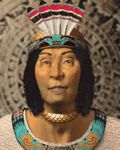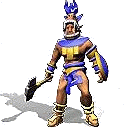The Aztecs |
|||||||||||||||||||||||
| Profile | |||||||||||||||||||||||
|
|||||||||||||||||||||||
|
Aztec Cities
Great Leaders
|
Background
The origin of the Aztec people is uncertain, but elements of their own tradition suggest that they were a tribe of hunter-gatherers on the northern Mexican plateau before their appearance in Meso-America in the 12th century. The Aztec were so called for Aztlán (“White Land”), an allusion to their origins in northern Mexico. It is possible that their migration southward was part of a general movement of peoples that followed, or perhaps helped trigger, the collapse of the Toltec civilization. The Aztecs settled on islands in Lake Texcoco and in 1325 founded Tenochtitlán, which remained their chief city. The basis of the Aztec’s success in creating a great state and ultimately an empire was their remarkable system of agriculture, which featured intensive cultivation of all available land, as well as elaborate systems of irrigation and reclamation of swampland. The high productivity gained by these methods made for a rich and populous state. The empire the Aztecs established was equaled in the New World only by that of the Incas of Peru, and the brilliance of their civilization is comparable to that of other great ancient cultures of the New and the Old World. Under a succession of ambitious kings they established a dominion that eventually stretched over most of present-day Mexico. By commerce and conquest, Tenochtitlán came to rule an empire of 400 to 500 small states, comprising by 1519 some five- to six-million people spread over 80,000 square miles. Valor in war, notably in the feared Jaguar Warrior formations, was the surest path to advancement in Aztec society, which was caste- and class-divided but nonetheless vertically fluid. The priestly and bureaucratic classes were involved in the administration of the empire, while at the bottom of society were classes of serfs, indentured servants, and outright slaves. The incredible story of a wandering tribe that was able to build an empire in one century (from the beginning of the 14th century to the beginning of the 15th) can be largely explained by three main factors: the Aztec religion, the thriving trade routes centered on Tenochtilán, and Aztec military organization. In 1502 the ninth emperor Montezuma II (1502-1520) succeeded his uncle Ahuitzotl as the leader of an empire that had reached its greatest extent, stretching from what is now northern Mexico to Honduras and Nicaragua. The Aztec empire was still expanding, and its society still evolving, when its progress was halted in 1519 by the appearance of Spanish adventurers. Montezuma was taken prisoner by Hernándo Cortés and died in custody. Montezuma’s successors, Cuitláhuac and Cuauhtémoc, were unable to stave off the conquistadors and, with the Spanish sack of Tenochtitlán in 1521, the Aztec empire came to an end. Unique Unit: the Jaguar Warrior
The Jaguar Warrior is an upgraded version of the warrior. With an additional movement point, the Jaguar Warrior can quickly rush an enemy unit or descend on a city to attack.
|
||||||||||||||||||||||

 The Aztecs are religious and militaristic. They start the game with Warrior Code and Ceremonial Burial and build Jaguar warriors instead of normal warriors.
The Aztecs are religious and militaristic. They start the game with Warrior Code and Ceremonial Burial and build Jaguar warriors instead of normal warriors.  As a militaristic society, the Aztecs placed a very high emphasis on honor and battlefield skill. After an Aztec warrior captured four or five enemy soldiers, he could advance to the rank of Eagle or Jaguar Warrior. These ranks provided unique benefits, such as exemption from taxes. Jaguar Warriors were fearsome combatants who wore colorful costumes including elaborately plumed headgear and Jaguar pelts, and wielded war shields (chimalli) and obsidian-tipped weapons such as war hammers and swords.
As a militaristic society, the Aztecs placed a very high emphasis on honor and battlefield skill. After an Aztec warrior captured four or five enemy soldiers, he could advance to the rank of Eagle or Jaguar Warrior. These ranks provided unique benefits, such as exemption from taxes. Jaguar Warriors were fearsome combatants who wore colorful costumes including elaborately plumed headgear and Jaguar pelts, and wielded war shields (chimalli) and obsidian-tipped weapons such as war hammers and swords.